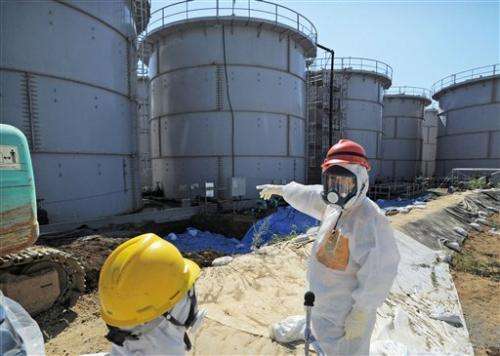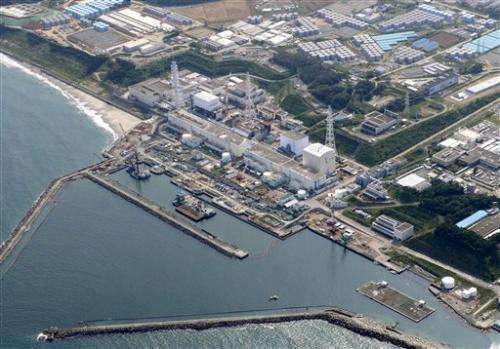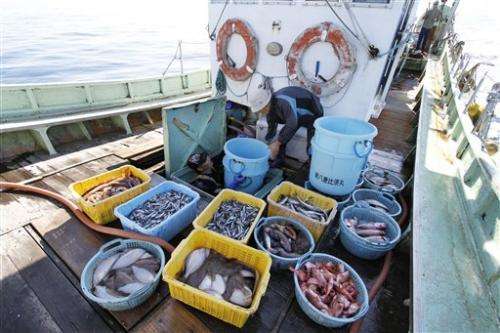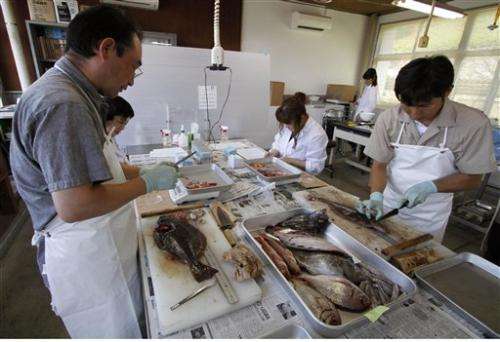In this Aug. 26, 2013 file photo, Japanese Trade Minister Toshimitsu Motegi, right, in a protective gear inspects storage tanks at the Fukushima Dai-ichi nuclear plant at Okuma town in Fukushima prefecture, northeastern Japan. Just weeks after Japanese officials acknowledged that radioactive water has been seeping into the Pacific from the tsunami-crippled nuclear power plant for more than two years, new revelations of leaks of contaminated water from storage tanks have raised further alarm. The government announced the week of Sept. 1, 2013 that it would contribute 47 billion yen ($470 million) to build an underground "ice wall" around the reactor and turbine buildings and develop an advanced water treatment system. (AP Photo/Kyodo News, File)
New revelations of contaminated water leaking from storage tanks at the tsunami-ravaged Fukushima Dai-ichi nuclear power plant have raised alarm, coming just weeks after Japanese officials acknowledged that radioactive water has been seeping into the Pacific from the plant for more than two years, The government announced this week that it would contribute 47 billion yen ($470 million) to build an underground "ice wall" around the reactor and turbine buildings and develop an advanced water treatment system. A look at the problem, and the potential risks to fish and the humans who eat them.
Q: How much radiation-contaminated water is leaking into the sea?
A: Experts estimate at least 300 tons every day. And that's just from one of two major sources: groundwater that flows through contaminated maintenance tunnels and pits on site. Water with even higher levels of radiation is believed to be escaping through cracks in the basements of the damaged nuclear reactors and their turbines and slowly making its way through the ground to the sea. Exactly how much is unknown. Plant operator Tokyo Electric Power Co., or TEPCO, even says there is no clear evidence of any leaks, though it acknowledges that possibility.
Q: That sounds like a lot of water, but the ocean is big. How dangerous is it?
A: The main health concern is the impact on fish near the nuclear plant. Scientists have long believed that contaminated water was reaching the ocean, based in part on continuing high levels of radioactive cesium found in fish living at the bottom of the sea. A rise in strontium-90 and tritium levels in the past few months needs to be watched, said Ken Buesseler, a marine chemist at Woods Hole Oceanographic Institution. Strontium in particular accumulates in fish bones and remains longer than cesium in fish and the humans that eat them. The fisheries off Fukushima are currently closed.
This aerial photo taken on Aug. 31, 2013, shows the Fukushima Dai-ichi nuclear plant at Okuma town in Fukushima prefecture, northeastern Japan. Just weeks after Japanese officials acknowledged that radioactive water has been seeping into the Pacific from the tsunami-crippled nuclear power plant for more than two years, new revelations of leaks of contaminated water from storage tanks have raised further alarm. The government announced the week of Sept. 1, 2013 that it would contribute 47 billion yen ($470 million) to build an underground "ice wall" around the reactor and turbine buildings and develop an advanced water treatment system. (AP Photo/Kyodo News)
Q: Why is there so much radioactive water?
A: The 300 tons per day is simply part of the underground water that runs down from surrounding mountains and through the nuclear complex on its way to the sea. In addition, nearly 400 tons of cooling water is pumped into the plant every day to keep the remaining fuel from overheating, and that water eventually spills into the basement. Another 400 tons of groundwater seeps into the basement through cracks, and mixes with the contaminated water. Water is constantly pumped out of the basements, but some of it escapes through other cracks. Half of the pumped-out water is re-used to cool the fuel, and the rest is stored in tanks.
In this Aug. 26, 2013 file photo, fishermen, Choji Suzuki, top, and his son, Fumio, work together after sorting out fish they caught aboard their boat Ebisu Maru in the waters off Iwaki, Japan, about 40 kilometers (25 miles) south of the Fukushima Dai-ichi nuclear power plant. Suzuki's boat is one of 14 fishing boats at his port recruited by Fukushima Prefecture to conduct once-a-week fishing expeditions in rotation to measure radiation levels of fish they catch in the waters off Fukushima. Fishermen in the Iwaki fishing ports had hoped to resume test catches in September following favorable sampling results after two years of the disaster. But those plans have now been scrapped after the recent news of radiation contaminated water leak from storage tanks at the nuclear power plant. Just weeks after Japanese officials acknowledged that radioactive water has been seeping into the Pacific from the tsunami-crippled nuclear power plant for more than two years, new revelations of leaks of contaminated water from storage tanks have raised further alarm. (AP Photo/Koji Ueda, File)
Q: What about the leaks in the tanks?
A: So far, that's a smaller problem, but there are fears it could become more widespread. The largest leak to date was 300 tons, and all the water in the tanks has been treated to remove cesium, one of most dangerous of the radioactive elements. The plant has more than 1,000 tanks holding 335,000 tons of contaminated water, and TEPCO plans to increase capacity up to 800,000 tons over the next three years.
Q: Is this problem ever going to end?
In this Aug. 26, 2013 file photo, laboratory workers at Fukushima Prefecture Fisheries Research Center dissect fish caught earlier in the day by local fishermen, before conducting radiation tests in Iwaki, Japan, about 40 kilometers (25 miles) south of the Fukushima Dai-ichi nuclear power plant. Fourteen fishing boats at a port in the city were recruited by Fukushima Prefecture to conduct once-a-week fishing expeditions in rotation to measure radiation levels of fish caught in the waters off Fukushima. Fishermen in the Iwaki fishing ports had hoped to resume test catches in September following favorable sampling results after two years of the disaster. But those plans have now been scrapped after the recent news of radiation contaminated water leak from storage tanks at the nuclear power plant. Just weeks after Japanese officials acknowledged that radioactive water has been seeping into the Pacific from the tsunami-crippled nuclear power plant for more than two years, new revelations of leaks of contaminated water from storage tanks have raised further alarm. (AP Photo/Koji Ueda, File)
A: Ice walls aside, the most realistic solution is to purify water to safe levels and release it into the sea. A water treatment unit intended to do that failed during a test run and is being repaired. The government is planning to fund the development of a more advanced unit over the next two years. There is no technology to remove tritium, however, so that could become a risk if levels continue to rise.
© 2013 The Associated Press. All rights reserved.



























